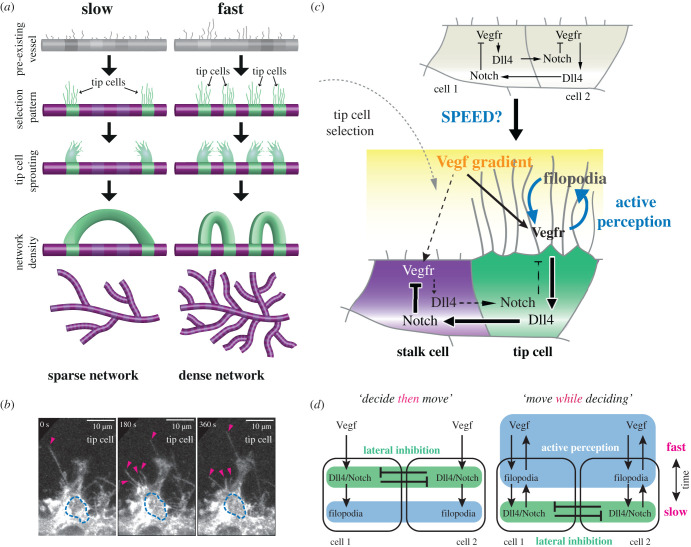Figure 1.
Mechanisms of tip selection during vascular network formation (angiogenesis): (a) a pre-existing vessel becomes activated by factors in a hypoxic tissue environment (low in oxygen) starting the process of tip selection where an alternating ‘salt and pepper’ pattern of tip (green) and stalk cells (purple) emerges. Tip cells then migrate out, extending new branch ‘sprouts’, which fuse (anastomosis) to form loops supporting blood flow. The speed of selection determines the branch spacing properties of the resulting blood vessel network. Fast patterning leads to a denser network, slow patterning leads to a sparser network. (b) Representative time-lapse images of filopodia extension from a tip cell migrating from the dorsal aorta (DA) upwards to form the intersegmental vessel (ISV) of a Tg(kdrl:ras-mCherry)s896 embryo. The dotted blue lines highlight the nucleus of the tip cell. Pink arrows mark filopodia. (c) The Vegf/Notch tip selection pathways. Vegf interacts with Vegfr-2, expressed at the surface of the endothelial cells and on filopodia. Vegfr-2 activation triggers Dll4 gene expression up-regulation and actin polymerization causing filopodia extension (e.g. via Pi3 K). In turn, Dll4 ligands activate Notch receptors on the neighbouring cell triggering cleavage of the Notch intracellular domain (NICD), which translocates to the nucleus reducing gene expression of Vegfr-2 receptors (and other pathways). Differences in Vegfr activation are amplified by this lateral inhibition competition between the cells until one cell has more Vegfr-2 receptors (which can continue stimulating the actin migratory response) and Dll4 (tip cell) inhibiting its neighbour (stalk cell, which has higher Notch activation levels and less Vegfr). (d) Two ways to conceptually frame how Notch decisions take place. One way corresponds to the prevailing view of the process ‘decide then move’ which designates filopodia as the end result of the selection decision-making process—prominent on migrating tip cells. The ‘move while deciding’ view, which takes into account the relative timescales of events, implicates filopodia ahead of Notch, driving the decision-making process. (Online version in colour.)

